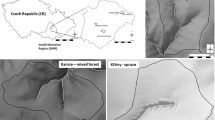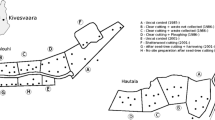Abstract
In a river, the flow directly affects the physical and chemical properties of its water, with further consequences for aquatic biota. Land use practices and vegetation cover play a significant role in the water cycle. The wide-spread perception of forest cover, in terms of hydrology is that forests may reduce water runoff: although in rare instances the contrary has been reported. Water runoff varies seasonally and depends on the forest tree species. By no means can it be considered constant over large expanses of area or for various rainfall patterns. In this paper, the results of a long-term hydrological survey conducted in two experimental microbasins (operated by the Institute of Hydrology SAS, IH SAS) with different land use practices are presented. The Rybárik microbasin (0.119 km2) is dominated by row crop production. The basin was 70% cultivated by the state farm and 30% by a private farm. The Lesný microbasin (0.086 km2) is covered by a deciduous hornbeam regrowth forest (Carpinus betulus). The analysis revealed that the difference in the runoff from the forest and the agricultural land increases with increasing precipitation; however, at some point (extreme precipitations with low probability) the runoff from these basins is nearly equal.
Similar content being viewed by others
References
Baker D.B., Richards R.P., Loftus T.T. & Kramer J.W. 2004. A new flashiness index: characteristics and applications to Midwestern rivers and streams. J. Am. Water Res. Ass. 40:503–522.
Bloeschl G., Ardoin-Bardin S., Bonell M., Dortinger M., Goodrich D., Gutknecht D., Matamoros. D., Merz B., Shand P. & Szolgay J. 2007. At what scales do climate variability and land cover change impact on flooding and low flows? Hydrol. Proc. 21: 1241–1247.
Demeterová, B., & Škoda P. 2009. Low flow in selected streams of Slovakia. J. Hydrol. Hydromech. 57: (In press).
DVWK 1999. Wahl des Bemessungshochwassers. DVWK Regeln 101/1999, Verlag Paul Parey, Hamburg.
Fišák J., Skřivan P., Tesař M., Fottová D., Dobešová I. & Navrátil T. 2006. Forest vegetation affecting the deposition of atmospheric elements to soils. Biologia 61(Suppl. 19): 255–260.
Flynn K.M., Kirby W.H. & Hummel P.R. 2006, User’s manual for program PeakFQ, Annual Flood Frequency Analysis Using Bulletin 17B Guidelines. U.S. Geological Survey Techniques and Methods Book 4, Chapter B4, 42 pp.
Fottová D. 2003. Trends in sulphur and nitrogen deposition fluxes in the Geomon network, Czech Republic, between 1994 and 2000. Water Air Soil Pollut. 150: 73–87.
Gelfan A.N., Pomeroy J.W. & Kuchment L.S. 2004. Modeling forest cover influences on snow accumulation, sublimation, and melt. J. Hydrometeorol. 5: 785–803.
Hlavčová K. 1993. Impact of stochastic properties of precipitation on erosion processes on slopes. J. Hydrol. Hydromech. 41: 68–82.
Holko L., Kostka Z., Lichner Ľ. & Píš V. 2006. Variation of nitrates in runoff from mountain and rural areas. Biologia 61(Suppl. 19): 270–274.
Hruška J. & Krám P. 2003. Modelling long-term changes in stream water and soil chemistry in catchments with contrasting vulnerability to acidification (Lysina and Pluhuv Bor, Czech Republic). Hydrol. Earth Syst. Sci. 7: 525–539.
Humbert J. & Najjar G. 1992. Influence de la foręt sur le cycle de l’eau en domaine tempéré. Une analyse de la littérature francophone. Strasbourg, France, CEREG.
Johnson D.W., Susfalk R.B., Gholz H.L. & Hanson P.J. 2000. Simulated effects of temperature and precipitation change in several forest ecosystems. J. Hydrol. 235: 183–204.
Komorníková M., Szolgay J. Svetlíková D., Szokeová D., Jurčák S. 2008. A hybrid modelling framework for forecasting monthly reservoir inflows. J. Hydrol. Hydromech. 56: 145–162.
Lenhart T., Fohrer N. & Frede H.G. 2003. Effects of land use changes on the nutrient balance in mesoscale catchments. Phys. Chem. Earth 28: 1301–1309.
Lepistö A., Granlund K., Kortelainen P. & Räike A. 2006. Nitrogen in river basins: Sources, retention in the surface waters and peatlands, and fluxes to estuaries in Finland. Sci. Total Environ. 365: 238–259.
Likens G.E., Buso D.C. & Butler T.J. 2005. Long-term relationships between SO2 and NOx emissions and SO 2—4 and NO —3 concentration in bulk deposition at the Hubbard Brook Experimental Forest. J. Environ. Monitor. 7: 964–968.
Magill A.H., Aber J.D., Currie W.S., Nadelhoffer K.J., Martin M.E., McDowell W.H., Melillo J.M., & Steudler P. 2004. Ecosystem response to 15 years of chronic nitrogen additions at the Harvard Forest LTER, Massachusetts, USA. Forest Ecol. Manag. 196: 7–28.
Miklánek P. & Pekárová P. 2007. Influence of forest on snowmelt runoff in small highland basins in Slovakia. Folia Geographica, ser. Geographica — Physica 37–38: 51–62.
Moldan B. & Černý J. 1994. Small Catchment Research, pp. 1–29. In: Moldan B. & Černý J. (eds), Biogeochemistry of small catchments. A tool for environmental research, John Wiley and Sons, Chichester UK.
Nature Conservancy, 2007. Indicators of Hydrologic Alteration. Version 7. User’s Manual. The Nature Conservancy. 75 pp.
Pekárová P., Koníček A. & Miklánek P. 2005. Impact of land use on runoff regime in experimental microbasins of IH SAS. Bratislava, Veda, 216 pp. (In Slovak)
Pekárová P., Onderka M., Miklánek P. & Halmová D. 2008. Mass balance of dissolved chemicals in microbasins with different land cover. Folia Geographica, ser. Geographica — Physica (in press).
Rafailov G. & Rafailova E. 2005. 40 years of hydrological, ecological and forestry studies at the experimental area of training and experimental forestry enterprise “Yundola”, pp. 9–16. In: Rafailov G., Gergov G., Raev I., Marinov I. & Rafailova E. (eds), Int. Conf. on Forest impact on hydrological processes and soil erosion, Publishing House of the University of Forestry, Sofia, Bulgaria.
Sebíň M., Pekárová P. & Miklánek P. 2007. Evaluation and indirect estimation of nitrate losses from the agricultural microbasin Rybárik. Biologia 62: 569–572.
Author information
Authors and Affiliations
Corresponding author
Rights and permissions
About this article
Cite this article
Pekárová, P., Miklánek, P., Onderka, M. et al. Water balance comparison of two small experimental basins with different vegetation cover. Biologia 64, 487–491 (2009). https://doi.org/10.2478/s11756-009-0100-0
Received:
Accepted:
Published:
Issue Date:
DOI: https://doi.org/10.2478/s11756-009-0100-0




